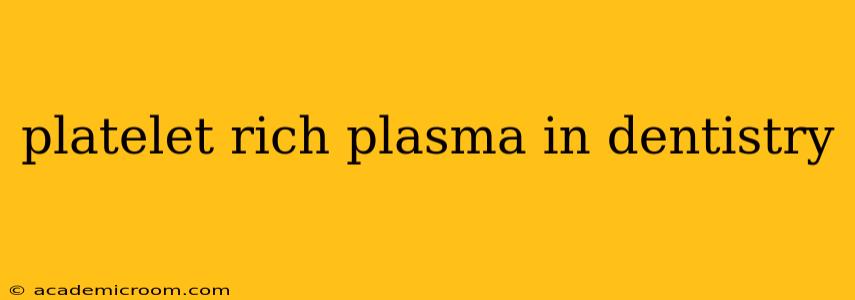Platelet-rich plasma (PRP) therapy has emerged as a promising regenerative technique in various medical fields, and its application in dentistry is rapidly gaining traction. This innovative approach leverages the body's natural healing mechanisms to promote faster tissue regeneration and improve overall oral health outcomes. This article delves into the uses, benefits, and potential drawbacks of PRP in dentistry, addressing common questions and concerns.
What is Platelet-Rich Plasma (PRP) and How Does it Work?
PRP is a concentration of platelets derived from a patient's own blood. Platelets are blood cells containing numerous growth factors, proteins that stimulate cell growth and tissue repair. The process involves drawing a small amount of blood, centrifuging it to separate the platelet-rich plasma from other blood components, and then injecting the concentrated PRP into the treatment area. These growth factors then work to accelerate the healing process, reducing inflammation and promoting tissue regeneration. It's essentially harnessing the body's own healing power for enhanced dental procedures.
What are the Uses of PRP in Dentistry?
PRP's versatility makes it a valuable tool in various dental applications. Some of the key uses include:
- Socket Preservation: Following tooth extraction, PRP can be applied to the extraction socket to stimulate bone and tissue regeneration, reducing the risk of bone loss and improving the chances of successful implant placement later.
- Guided Bone Regeneration (GBR): In cases of insufficient bone for dental implants, PRP can be combined with bone grafting materials to enhance bone formation and improve implant stability.
- Sinus Augmentation: PRP can be used to facilitate the growth of new bone in the maxillary sinus, a procedure often necessary before placing implants in the posterior maxilla.
- Periodontal Regeneration: In patients with periodontal disease (gum disease), PRP can help regenerate damaged periodontal tissues, including bone and ligaments.
- Soft Tissue Augmentation: PRP can improve the healing and aesthetics of soft tissues after periodontal surgery or other procedures, leading to better gum contour and appearance.
- Accelerated Healing After Oral Surgery: PRP can reduce post-operative pain, swelling, and recovery time after various dental procedures.
How Long Does PRP Treatment Last in Dentistry?
The longevity of PRP treatment effects varies depending on the specific application and individual patient factors. While PRP stimulates natural healing processes, it doesn't provide a permanent solution. The results of socket preservation, for example, might last for several months to years, while effects in periodontal regeneration might require ongoing maintenance. Your dentist will discuss the expected lifespan of the treatment in relation to your specific case.
Is PRP Treatment in Dentistry Painful?
The procedure itself involves a small blood draw and injection, which can cause mild discomfort. However, most patients report minimal pain, and local anesthesia can be used to further reduce any discomfort. Post-treatment pain is usually manageable with over-the-counter pain relievers.
What are the Potential Risks and Side Effects of PRP in Dentistry?
Generally, PRP therapy is considered safe with minimal side effects. However, potential risks include:
- Infection: As with any injection, there's a small risk of infection at the injection site.
- Bleeding: Minor bleeding at the injection site is possible.
- Bruising: Bruising may occur at the injection site.
- Pain or Swelling: Mild pain or swelling at the injection site is possible.
These side effects are usually mild and temporary. Your dentist will discuss the potential risks and benefits of PRP therapy before the procedure.
What is the Cost of PRP Treatment in Dentistry?
The cost of PRP treatment varies widely depending on the location, the specific procedure, and the amount of PRP used. It's generally considered a more expensive treatment option compared to traditional methods. It is best to consult your dentist for a personalized cost estimate.
Is PRP Treatment Covered by Dental Insurance?
Currently, most dental insurance plans do not cover PRP treatment, as it is considered a relatively new and advanced procedure. However, you should always check with your insurance provider to confirm coverage options.
Conclusion: A Promising Advance in Dental Regenerative Medicine
PRP therapy is a promising advancement in dental regenerative medicine, offering a less invasive and potentially more effective approach to various oral health challenges. While still relatively new, its growing body of research suggests it can significantly enhance healing, improve aesthetic outcomes, and enhance the success of complex dental procedures. If you are considering PRP treatment, discuss it with your dentist to determine if it's the right option for your individual needs. Remember, this information is for general knowledge and does not constitute medical advice; always consult with your dentist for personalized guidance.
